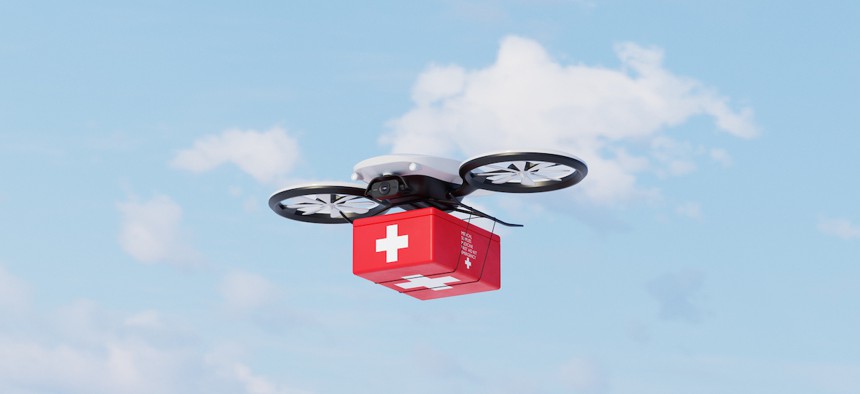Study: Drone technology has potential to help rural healthcare

J Studios via Getty Images
The study found patients at the receiving end of drone deliveries were eager to “embrace” the new technology and expressed willingness to use it again in the future.
This article first appeared on The Daily Yonder and is republished here under a Creative Commons Attribution-NoDerivatives 4.0 International License.
A study released in December of 2024 has found that drones not only can provide rural residents with access to healthcare resources, but that rural people are eager to embrace the new technology.
Researcher Ellen Hahn, associate director of AppalTRuST in the University of Kentucky College of Nursing, was on the research team for the study that looked at drone delivery of healthcare resources to Appalachian patients that was recently published in Health Promotion Practice. Although the study was limited, she said, it showed that the concept could work.
“We found that it was safe to use drones,” Hahn said. “Some of the research around drones and healthcare delivery says that people are kind of hesitant or skeptical, and we wondered what will a group of clients think? Well, they were very interested. They embraced it. Plus, the materials that we delivered to them by drone were things they didn't have access to.”
Hahn said the recently published study, conducted in 2020, wanted to see if drones could work in hard-to-reach areas such as remote parts of the Appalachian mountains.
The study involved partnerships with Kentucky Homeplace, a community health worker program that provides medical and social assistance to rural residents they might not otherwise have had access to; the University of Kentucky Center of Excellence in Rural Health; and USA Drone Port in Hazard, Kentucky. The study focused on delivering personal protective equipment during the Covid-19 pandemic.
Together with leaders in the Perry County Wellness Coalition, the team worked out a system to deliver PPE such as face masks to Kentucky Homeplace clients in Perry and Knott counties in rural southeastern Kentucky, with a combined population of about 42,000.
“A lot of these participants, because they have chronic illness, are homebound anyway,” Hahn said. “I thought it sounded interesting and could have a ripple effect, particularly during flooding and other disasters. The question was, could we use drones to get people what they needed when they can’t get things?”
After an initial consultation with their community healthcare workers about the program, the clients were able to tell workers where on their properties the drone could drop the delivery.
“As you can imagine, safety issues with power lines and trees and the weather were an issue, and we started this project in December (2020), so it was really winter into spring months,” Hahn said.
“We had to see how it would work. The community health workers had to delay it because of weather or power lines, or trees a few times, but it was a close collaboration with the community health workers who were trained as visual observers.”
Once patients received the delivery, research found they were more likely to use the PPE. Before the study, only 60% of patients said they wore a mask every day. After the drone delivery, 90% reported wearing a mask every day. And those reporting they would not go out in public without a mask went up ten percent after delivery. Of the study’s participants, 60% said they’d be willing to receive items via drone again, and 80% said they would like to schedule future deliveries of PPE items by drone at the end of the study.
The group also learned how to navigate the safety issues surrounding drones. Federal Aviation Administration (FAA) regulations require that drones cannot fly beyond visual sight of the operator and colleagues, which requires coordination of community healthcare workers and drone pilots. Also, USA Drone Port tested various basket weights and different basket materials to determine how to successfully make deliveries, according to the study.
Increasingly, medical officials and drone operators around the country are exploring how to use drones to get prescriptions and other healthcare resources to people in rural communities.
In Maryland, a University of Maryland team is testing using drones to get prescriptions to remote areas like Smith Island, a community ten miles west of the mainland where its nearly 200 residents are mostly older and homebound.
Their prescriptions are generally delivered by ferry, which only runs once a day, weather permitting. Officials on the island said that getting prescriptions becomes even more challenging when the water freezes.
“When the ice is heavy, it can take six hours to get there—if you can go at all,” Eddie Somers, a retired fishing boat captain and official on the island, said in a statement. Sometimes, he noted, it’s necessary to use an ice-breaking boat to get prescriptions to those in need.
John Slaughter, a retired Navy helicopter pilot, runs the University of Maryland’s Uncrewed Aircraft Systems Command and heard about the island’s issues during a talk with a Maryland doctor. Two of the doctor’s patients had run out of medicines during a freeze, which required the state to dispatch the medications in a helicopter. Slaughter thought the jobs could have been done with a drone.
“That helicopter costs thousands of dollars an hour to operate when you consider fuel, maintenance, flight crew, and ground crew,” Slaughter said in a press release
In November of 2024, the university was awarded a $1.76 million grant from the U.S. Department of Transportation to establish a drone operation to get medical shipments to rural residents in that state.
Last year, a similar project in Texas had rural practitioners work with Texas Tech University Health Sciences Center to test drone delivery of medical supplies to rural areas of that state. And in Michigan, an economic development organization headed a partnership to test drone delivery of medical supplies and other healthcare needs to residents in rural Michigan.
Hahn said her team’s research shows that drones can have an impact on the health of rural residents.
“It was a small study, but we did see a significant impact in people reporting access to resources that they didn’t have, which is really what we were going after,” she said.
![]()





